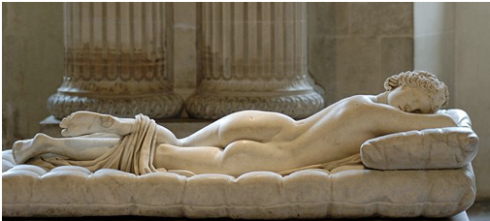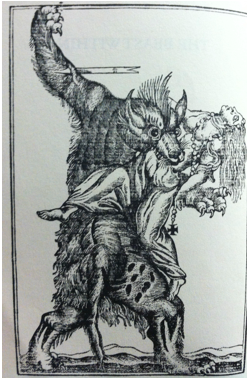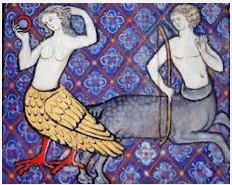
Monthly Archives: May 2014
Crossing Boundaries: Androgynous Women in English Renaissance Society & Theatre
By Adrianna M.
During the English Renaissance, gender was an unstable concept. Gender categories were based on the Greek anatomist Galen’s one-sex model, which claimed that “men and women had the same anatomical structures [but that] women were simply less perfect men” (Howard “Introduction” 1595). According to the model, gender could shift depending on individual actions. In order to prevent gender shifts, English society commonly recommended strict guidelines for the masculine and feminine roles that men and women should respectively play. While both genders were affected, my work focuses specifically on women. Women were seen as property and were not to question the authority of their male “owner” (usually their father or husband). If a woman acted against these social expectations then she was considered androgynous because of how she blended physical and behavioral categories. Thus, the belief in unstable gender meant that there was no distinction between being an androgyne (person who exhibits qualities of both sexes) and a hermaphrodite (person who contains organs of both sexes). 

Classical mythology depicted androgyny as a higher state of being; but in Renaissance society, androgynes were viewed more as monstrosities that threatened the desired “norm.” Female cross-dressers, as a result, were severely punished and accused “of being whores”, because not only did they change their dress but they used it to assert themselves in ways typically reserved for men (Howard “Crossdressing” 424).
In this world full of anxiety and restricting rules, “the theatre provided an arena where changing gender definitions could be displayed, deplored, or enforced and where anxieties about them could be expressed by playwrights” (Rackin 29). During the time all actors were male (since women were not supposed to speak in public), all female roles were performed by men. This created a double anxiety when it came to male actors playing female characters who cross-dressed, as in William Shakespeare’s Twelfth Night, As You Like It, The Merchant of Venice, Two Gentlemen of Verona, or Cymbeline. Yet androgyny could exist even when cross-dressing did not occur. Recognition of a female characters’ androgyny “lies beneath the texture of the drama, in the male characters’ attitudes towards [them], and tends to surface when the woman attempts to assert herself, either in thought or action” (Hansen 11).
In The Merchant of Venice, for example, Portia’s and Jessica’s respective androgynous natures differ. On the one hand, Jessica’s cross-dressing hurts her father and, after she leaves (thus disobeying his authority), he cries “She is damned for it” (Shakespeare 3.1.27). She has asserted her own choice by leaving, thus becoming androgynous, and her dress while leaving reinforces this. On the other hand, Portia initially has no living paternal authority to deny. She asserts her own power in telling Bassanio to marry her, even before she cross-dresses. Not only does she assert her own authority later by cross-dressing and acting as a lawyer, but she also dominates Bassanio when he returns from Venice and she returns to her feminine costume. She tricks him into giving her his ring, but then interrogates him about it. In so doing, she dominates the relationship, symbolically taking on the masculine role regardless of her clothing. Portia’s cross-dressing saves Antonio, thus saving the play from overt tragedy, but Jessica’s transgression hurts her father. The difference we can see then is that Jessica went against her preexisting authority, while Portia had the ability to choose her authority. In Renaissance society both transgressions would be seen as monsterous, but Shakespreare makes it known that one is in fact worse than the other.
__________________________________________________
Adrianna studies Rhetoric and Writing, Literature, and Marketing at Ball State University.
___________________________________________________
Image: Larique, David. Sleeping Hermaphroditus. 1619. Greek marble. Louvre, Paris. Wikimedia Commons. Apr. 2007. Web. 1 May 2014.
Bibliography
Hansen, Carol. Woman as Individual in English Renaissance Drama: A Defiance of the Masculine Code. New York: P. Lang, 1993.
Howard, Jean. ‘Introduction to As You Like It.’ Introduction. Norton Shakespeare: Based on the Oxford Edition.Ed.Stephen Greenblatt, Walter Cohen, Jean Howard, and Katherine Maus. New York: W.W. Norton and Company, 1997. 1595.
—. “Crossdressing, The Theatre, and Gender Struggle in Early Modern England.” Shakespeare Quarterly 39.4 (1988): 418-40.
Rackin, Phyllis. “Androgyny, Mimesis, and the Marriage of the Boy Heroine on the English Renaissance Stage.” PMLA 102.1 (1987): 29-41.
Shakespeare, William. The Merchant of Venice. Ed. Leah S. Marcus. New York: W.W. Norton and Company, 2006.
Lycanthropy as a Mental Illness in Webster’s “The Duchess of Malfi”
By Emily G.
In Renaissance England, werewolves represented societal anxieties about the relationship between a human’s body and mind. Although lycanthropy has many definitions, the most prominent comment upon transformations of man into wolf: a “werewolf.” Yet other definitions move away from the body, referring instead to the “delusion that one was capable of such transformations,” commonly known as lycanthropes (Hirsch). While the two definitions seem separate today, the distinction was less over in early modern England, where the terms were used interchangeably even after the idea of the werewolf fell out of use (Hirsch). By the end of the fifteenth century, the wolf was extinct in England, and the fear of wolves disappeared (Douglas 2); (Hirsch); (Douglas 231). Subsequently, so did the fear of werewolves. Theologians and demonologists admitted that actual animal-human transformation was impossible, claiming that even the devil could not transform a human into an animal (Wiseman 58). Thus, lycanthropy was understood most frequently as a mental illness in which the patient believed he or she had transformed into an animal. Physicians believed this phenomenon resulted from too much melancholy or an unnatural imbalance in one of the four humors of the body (Douglas 231); (Hirsch).
John Webster’s The Duchess of Malfi arrived on stage in 1614 to tell the story of Ferdinand, a melancholy lycanthrope (Wiseman 59). Although Ferdinand alludes to wolves frequently throughout the tragedy, as when he calls the Duchess’s children “cubs,”, he is not diagnosed by the Doctor until the final act: “A very pestilent disease, my lord,/ They call lycanthropia” (Webster 4.1.33); (Webster 4.2.5-6). However, if we assume that Ferdinand’s lycanthropy is induced by an excess of melancholy, we can further argue that his affliction actually begins after the Duchess’s murder in act four, when he says, “I bade thee, when I was distracted of my wits,/ Go kill my dearest friend, and thou hast done’t” (4.2.279-280). Although he ordered Bosola to murder his sister, he gets angry after the fact. When he says “I was distracted of my wits,” his language suggests that his madness has already begun. The illness takes a turn for the worst in act five. The Doctor mentions seeing “the duke, ’bout midnight in a lane/ Behind the Saint Mark’s church, with the leg of a man/ Upon his shoulder; and he howl’d fearfully;/ Said he was a wolf; only the difference was, a wolf’s skin was hairy on the outside,/ His on the inside” (Webster 5.2. 14-18).
Lycanthropy represented many anxieties not only about the body, but the mind as well. If lycanthropy is the result of madness, are lycanthropes still responsible for their actions (Hirsch)? To simply consider the existence of the werewolf was to consider the state of the mind and soul, as well as the possibility of the human brain transcending into an animal one (Wiseman 58). Many of the images, engravings, or sculptures of lycanthropes feature a horrifying hybrid creature that stands upright like a man but is nevertheless covered in fur from head to foot, with sharp claws and teeth. In the image above, the werewolf even has his jaws clamped down on a young woman. These depictions highlight society’s fear of the illness, and the anxiety that attackers could transform victims into such beasts as well. In fact, werewolves were considered more dangerous than regular wolves because they were a hidden threat (Hirsch). While wolves displayed their violence on the outside, covered in fur, lycanthropes were “hairy on the inside,” like Ferdinand suggests. In a sense, even though lycanthropes do not physically transform, they constantly blur the line between man and beast and the status of being human, causing anxieties about the body, mind, and soul during the English Renaissance.
________________________________________________
Emily studies English Literature and Creative Writing as a junior at Ball State University.
_________________________________________________
Image: Douglas, Adam. “The class image of the bloodthirsty werewolf.” The Beast Within. London: Chapmans Publishing Ltd., 1992. Print.
Douglas, Adam. The Beast Within. London: Chapmans Publishing Ltd., 1992. Print.
Hirsch, Brett D. “An Italian Werewolf in London: Lycanthropy and the Duchess of Malfi.” Early Modern Literature Studies 11.2 (2005): 2-43. Web. 25 February 2014.
Webster, John. The Duchess of Malfi. Ed. John Russel Brown. Cambridge: Harvard University Press, 1964. Print.
Wiseman, S.J. “Hairy on the Inside: Metamorphosis and Civility in English Werewolf Texts.” Renaissance Beasts: of Animals, Humans, and Other Wonderful Creatures . Ed. Erica Fudge. City of Chicago: University of Illinois Press, 2004. 50-69. Print.
Cultural Fantasies & (Un)Acceptable Realities in Literature
By Emily G., Adrianna M., Evan P., Melissa S., and Hannah V.
The research shaping our series of posts examines the social issues addressed in English Renaissance literature and drama. We have found that what was considered largely unacceptable in the “reality” of Early Modern England was welcomed onstage or in a work of literature, and that the job of art was not only to replicate a semblance of reality, but also to comment on what that social reality lacked. Since strict principles of hierarchy and subordination structured the culture of the time, playwrights and writers had the opportunity either to challenge or to uphold the public’s expectations. They did this through the inclusion of half-human creatures and magical beings such as fairies, ghosts and spirits, androgynous humans, and werewolves.
All of the half-human creatures that we studied arose from social anxieties about the body; and they reflected a popular desire to separate “the human” from “the animal” and “the non-human.” Humans elevated some creatures above themselves, including as magical beings and fairies; meanwhile they shunned others as lesser, placing in this category spirits, androgynous humans, and werewolves. What tied these categories together is that many of the figures in both challenged anthropocentric views of humanity. What’s more, writers attempted to mitigate some anxieties by positioning non-human figures as plot devices: ghosts were commonly created for the purpose of revenge, androgyny was often depicted in a comedic light, and werewolves were considered human minds doomed to life in the body of an animal as punishment. These issues guided our research and led to questions of how non-human creatures alleviated or heightened the preexisting anxieties and how they were employed by or against humanity. A deeper understanding of these questions shaped our view that literature and drama used these half-human creatures to define humanity.

